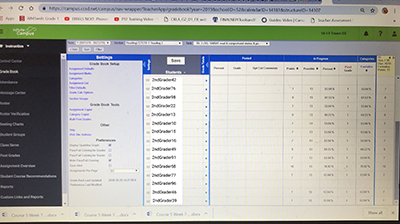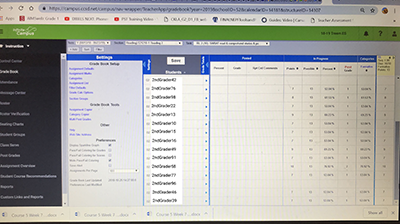So, second-grade students in the fall of 2018 at Treem Elementary were not learning math. However, their learning difficulties were not limited to that basic subject: Common Core reading instruction was also failing, as the images below show.
IMG_3187: Reading assessments: Kids not learning #1
If clicked and enlarged, this screenshot shows the detailed results of a reading and comprehension test dated October 18. In the task slot atop this page, the word “SWBAT” is Common-Core jargon for “Student Will Be Able To.” In this case, it is to be able to “read & comprehend stories…,” etc. Check the column labeled “Percent,” under “In Progress.” Once again, class learning was not proceeding, as the grades on this quiz show, averaging 58.57%, or an F.
IMG_3146: Reading assessments: Kids not learning #2
This screenshot reveals that the second graders were doing worse under the Common-Core “Reading Literature” curriculum the longer the class proceeded. (To see a large image, click on the graphic.) The central column under the “In Progress” label and then below the word, “Percent,” takes the three different “Composite Percent” columns to the right of the vertical blue line and averages them. Those columns reveal the deterioration increased as the curriculum proceeded.
Early-childhood experts have long recognized that young children “must first learn something through the stage of ‘romance’ where topics are made fascinating, [before] they can then move on to the next stage of ‘precision.’
“The Common Core skips this essential first stage of learning and takes the learning process itself and slices it into hundreds of tiny fragments that in and of themselves have little to entice young minds.” The quotation is from Thomas Armstrong, Ph.D., of the American Institute for Learning and Human Development. But it’s also a widespread criticism of Common Core among other experts on early-childhood learning. (See Joint Statement of Early Childhood Health and Education Professionals on the Common Core Standards Initiative, March 2, 2010.)
So what was the response of Treem administrators to such a serious educational failure, one over which they had presided?
It was, once again, to simply falsify the test results and attempt to conceal the children’s learning deficit from their parents.
Phonics: The foundation for reading success
Before students can become efficient readers, they need an understanding of the relationship between the letters in words and their sounds. With an understanding of that subject — called “phonics” — a youngster can come up with an approximate pronunciation of a word and then check it against his or her existing oral vocabulary.
For that reason, the school year for second graders starts with a couple of weeks of phonics. The curriculum then moves on to small stories, in which the children should be able to ground their understanding of this new phonics skill in their actual experience.
Double Trouble in Treem’s Sandbox
One of the first small stories intended to test second-graders’ understanding of phonics is called “Trouble in the Sandbox.” At least 10 of the screenshots downloaded by the whistleblowing teacher who contacted Nevada Journal were assessments, or tests, of the children’s learning associated with that story.
The tests in those screenshots fall into two categories: those that candidly document the students’ significant lack of understanding, and others that suddenly show all students performing amazingly well, perfectly answering 100 percent of the questions correctly.
Note this page of genuine phonics assessment records for example, which aggregates grade data for a “Reading Literature” progress report. Three different assessments given the class are shown, and then also averaged under the labels “In Progress,” “Percent” and “Post Grade.” Nowhere were student grades higher than a “D.”
Indeed, it is almost certain that the underlying educational reality was even worse. Partial data at the level of individual students — see this page and this one — suggest that most of the second graders probably scored well below the F level, a result concealed by CCSD’s “no grade lower than an F” policy.
The second category of screenshots — those intended to show the class performing exceptionally well by containing only one question — begin with this one. First, notice the “02” in red at the far-left edge of the document. That red color means this particular student had actually left Treem well before the date this overlay was made. It’s an automatic feature of the Infinite Campus software to put departed students’ names in red. Also notice the comments at the right saying “brought to minimum F, scored a 0.” That also is a comment automatically applied by the same software algorithm — but, supposedly, only in the first couple of weeks of the second-graders’ school year, says Oliver. Its purpose was to soften the initial impact, for the children, of being subjected to a grading regimen. Thus, wherever this message appears in the comment box, it’s a telltale that the underlying test sheet, with its operative algorithm, actually was first produced much earlier in the school year.
Now see this page, and note the date at the upper left: 9/21/2018. Regularly shown in Infinite Campus on the classes’ phonics assessments, this date is, in itself, a huge red flag. That’s because September 21 comes some seven weeks into the school year, well after the first weeks of school when the phonics subject is taught and tested. Yet virtually all of these phonics assessments say “9/21/2018” near the top.
“Any test associated with phonics has to also, and always, begin at the start of school,” says the whistle-blowing teacher. “So that’s why we know for an absolute fact, that a phonics test saying ‘9/21/2018’ was one where the original scores had been erased and the test had been given again on 9/21/2018.”
In giving the test a second time, speculates the teacher, the administrators most likely were assuming that “seven weeks later in the school year, the kids should have been able to breeze through these tests very easily.”
And with better results on a new test, the school’s earlier instructional failure could be obscured.
If that had been their plan, however, Treem administrators would have been forgetting how little the second-grade class had learned. Two different substitutes had already come and gone, finding the classroom’s students impervious to CCSD’s ham-handed implementation of the Common-Core curriculum.
One of the two subs had left after a single week. The other had left after eight weeks — notwithstanding efforts by several other teachers to help her make the Common-Core concepts meaningful to the class.
Given the profound educational failure over which the Treem administration had inattentively presided, it seems doubtful the second graders would ever, without special remediation, have been able to demonstrate phonics competence.
And that seems to have also been the eventual conclusion of Treem administrators. The testing-score overlays that were subsequently used to manufacture the mass forging of grades suggest that conclusion through the fact that administrators had, on September 21, sought to ensure the illusion of learning with another single-point test — results apparent here, here, and here — for which the single answer had been drilled into the kids.
It was in this way that all the class’s students — who had previously averaged Fs on the earlier testing — would now achieve ostensibly perfect scores: Remembering the answer to a single question would get each of them an “A.”
Of course, under Common Core, all classes at a given grade level are to give the same exact tests, so that results can be compared. Any teachers caught making up their own tests — with, say, just a single question on which the kids had been drilled — would be fired, says the whistleblower. Yet that’s what these administrators did.
According to a fellow teacher of the whistleblower, all student grades prior to 9/21/2018 had been erased from the Infinite Campus cloud by Treem administrators. And although they then re-gave some of the easier tests to students, those were exceptions.
“Mostly, however, the students did not retake tests,” the whistleblower reports. “Instead, the administrators just filled in A’s and B’s on most of the tests. For as far as I know, nobody has seen any real test results.”
Of course, the basic question remains: If the children’s real grades were all F’s up to the point in October when administrators took over, how, then, could they now — on report cards delivered to parents — be showing all these A’s?
Conclusion
The account that James Oliver has given the public of the October 2018 events at Treem ES is well-documented by a massive collection of digital screenshots. Similarly, his narrative of the events at CCSD’s ‘Pink Palace’ on the afternoon of January 11, 2019, is supported by not only the context in which that meeting occurred but also the supporting documentation submitted to CCSD brass prior to that meeting — documentation that Nevada Journal has established, through records requests made under the State of Nevada’s public records law, that CCSD leadership did, in fact, receive.
How extensive IS the fraud being perpetrated upon Nevada parents and their children?
Clearly, law enforcement — and Nevada parents — need to find out.


